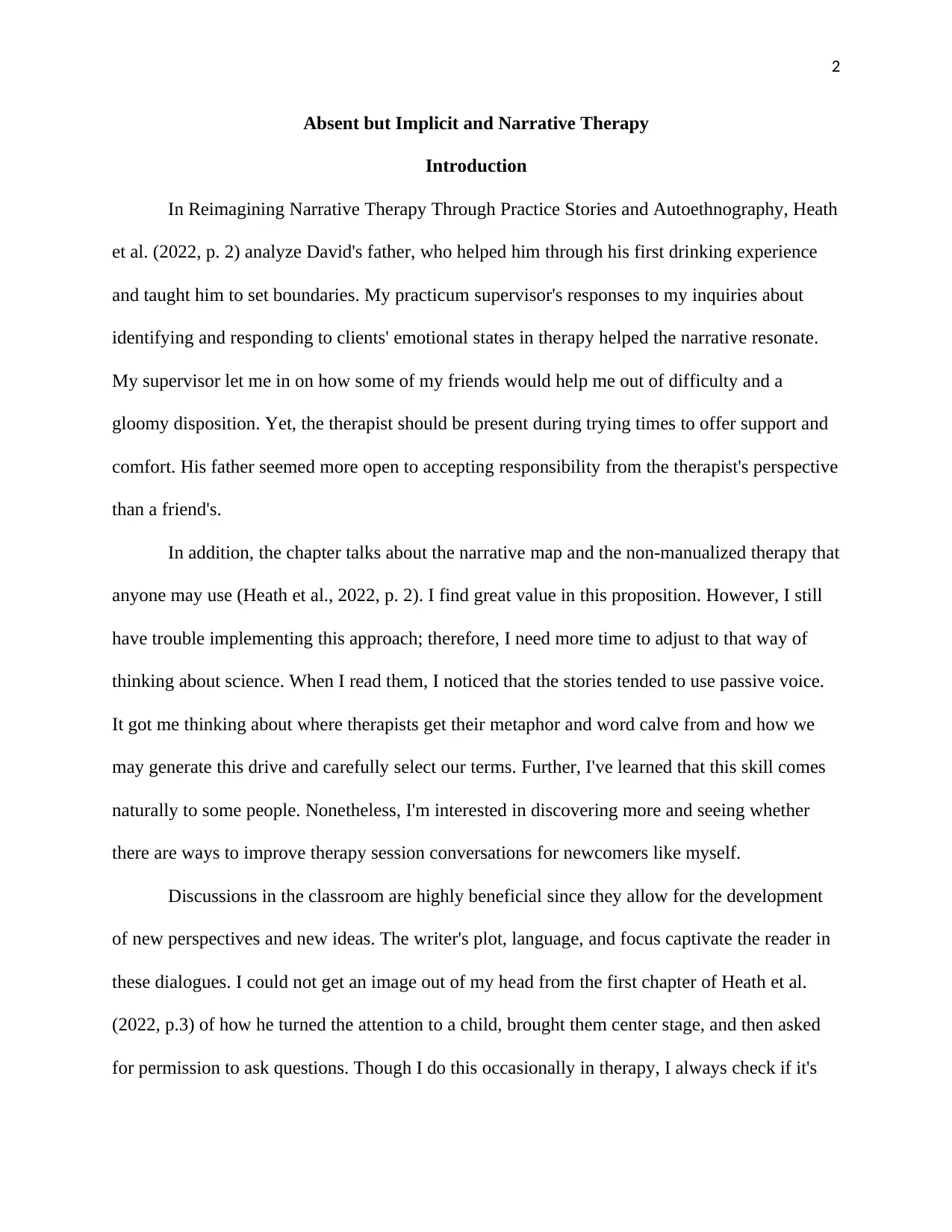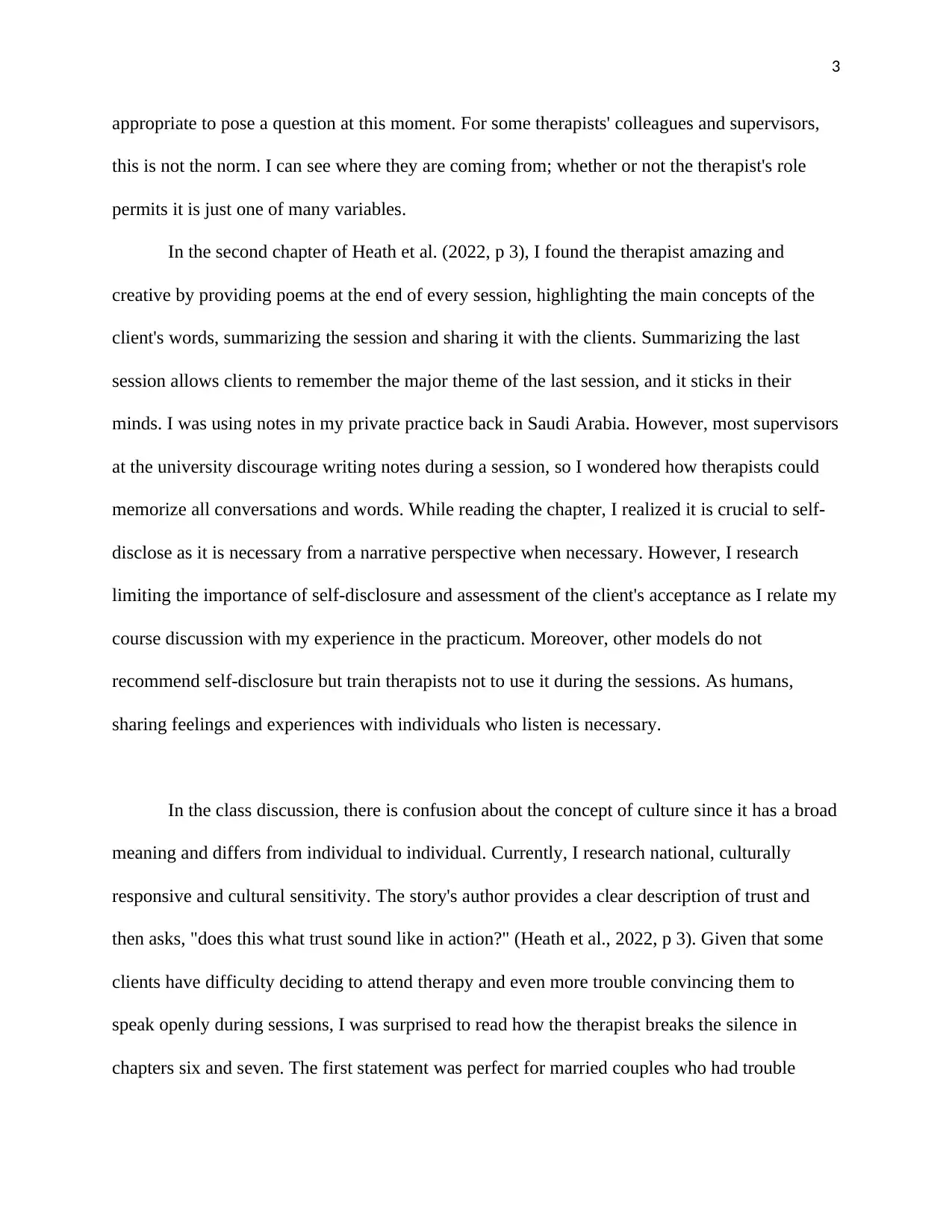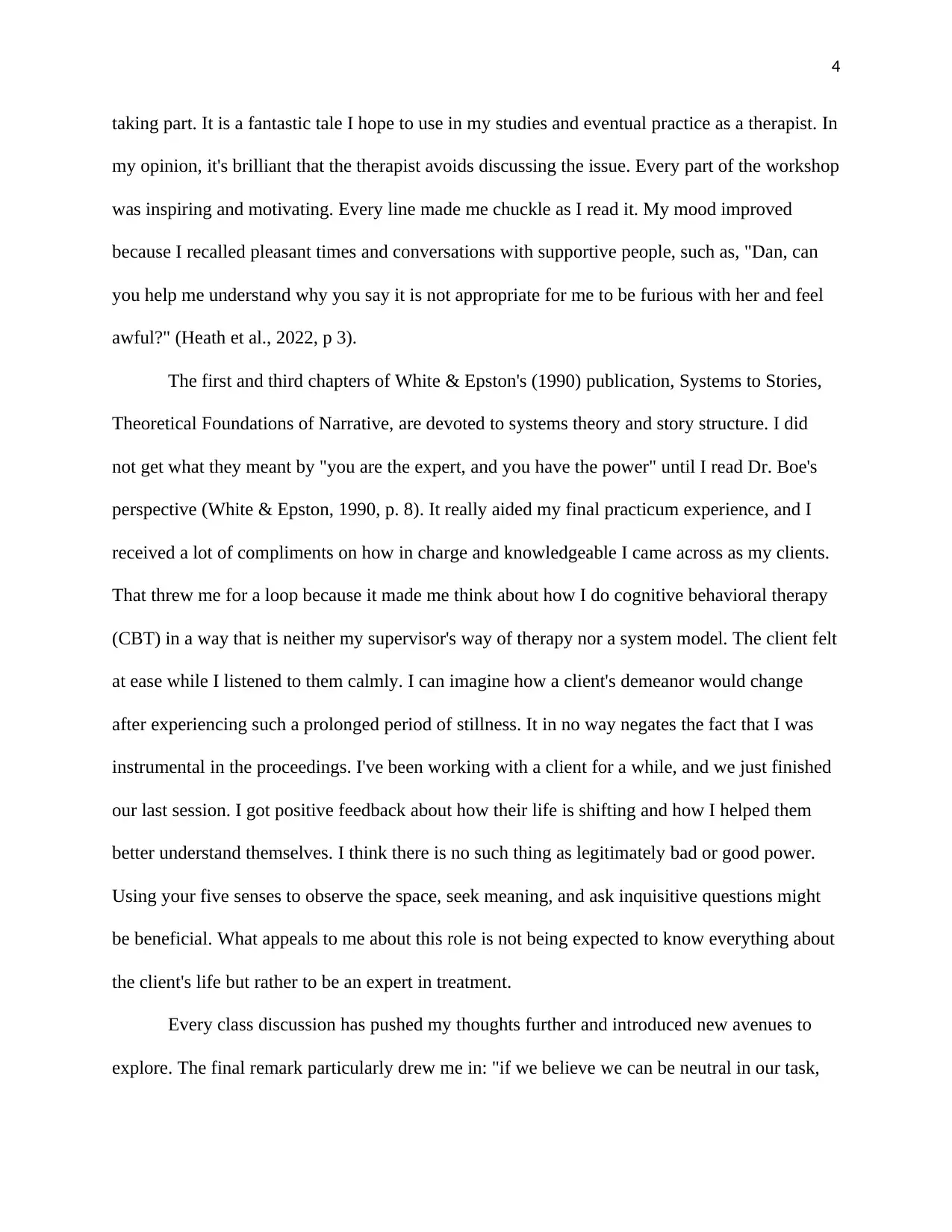Reflections on Absent but Implicit and Narrative Therapy Concepts
VerifiedAdded on 2023/05/08
|6
|1529
|465
Essay
AI Summary
This essay reflects on the application of 'absent but implicit' concepts within narrative therapy, drawing upon readings from Heath et al. (2022) and White & Epston (1990). The author explores personal experiences from practicum and private practice to understand the therapist's role, the importance of client-centered approaches, and the impact of self-disclosure. The essay highlights the challenges in integrating narrative therapy with other models like CBT and emphasizes the significance of cultural sensitivity and attentive listening in therapeutic practice. The author also discusses the value of collaborative discussions in developing new perspectives and approaches to therapy, particularly in addressing sensitive issues such as trauma and marital conflict. The essay concludes with a reflection on the ongoing learning process and the commitment to applying narrative therapy techniques effectively in future practice. Desklib provides this essay and many other resources for students.

1
Absent but Implicit and Narrative Therapy
Name
Course
Institution
Instructor
Date
Absent but Implicit and Narrative Therapy
Name
Course
Institution
Instructor
Date
Paraphrase This Document
Need a fresh take? Get an instant paraphrase of this document with our AI Paraphraser

2
Absent but Implicit and Narrative Therapy
Introduction
In Reimagining Narrative Therapy Through Practice Stories and Autoethnography, Heath
et al. (2022, p. 2) analyze David's father, who helped him through his first drinking experience
and taught him to set boundaries. My practicum supervisor's responses to my inquiries about
identifying and responding to clients' emotional states in therapy helped the narrative resonate.
My supervisor let me in on how some of my friends would help me out of difficulty and a
gloomy disposition. Yet, the therapist should be present during trying times to offer support and
comfort. His father seemed more open to accepting responsibility from the therapist's perspective
than a friend's.
In addition, the chapter talks about the narrative map and the non-manualized therapy that
anyone may use (Heath et al., 2022, p. 2). I find great value in this proposition. However, I still
have trouble implementing this approach; therefore, I need more time to adjust to that way of
thinking about science. When I read them, I noticed that the stories tended to use passive voice.
It got me thinking about where therapists get their metaphor and word calve from and how we
may generate this drive and carefully select our terms. Further, I've learned that this skill comes
naturally to some people. Nonetheless, I'm interested in discovering more and seeing whether
there are ways to improve therapy session conversations for newcomers like myself.
Discussions in the classroom are highly beneficial since they allow for the development
of new perspectives and new ideas. The writer's plot, language, and focus captivate the reader in
these dialogues. I could not get an image out of my head from the first chapter of Heath et al.
(2022, p.3) of how he turned the attention to a child, brought them center stage, and then asked
for permission to ask questions. Though I do this occasionally in therapy, I always check if it's
Absent but Implicit and Narrative Therapy
Introduction
In Reimagining Narrative Therapy Through Practice Stories and Autoethnography, Heath
et al. (2022, p. 2) analyze David's father, who helped him through his first drinking experience
and taught him to set boundaries. My practicum supervisor's responses to my inquiries about
identifying and responding to clients' emotional states in therapy helped the narrative resonate.
My supervisor let me in on how some of my friends would help me out of difficulty and a
gloomy disposition. Yet, the therapist should be present during trying times to offer support and
comfort. His father seemed more open to accepting responsibility from the therapist's perspective
than a friend's.
In addition, the chapter talks about the narrative map and the non-manualized therapy that
anyone may use (Heath et al., 2022, p. 2). I find great value in this proposition. However, I still
have trouble implementing this approach; therefore, I need more time to adjust to that way of
thinking about science. When I read them, I noticed that the stories tended to use passive voice.
It got me thinking about where therapists get their metaphor and word calve from and how we
may generate this drive and carefully select our terms. Further, I've learned that this skill comes
naturally to some people. Nonetheless, I'm interested in discovering more and seeing whether
there are ways to improve therapy session conversations for newcomers like myself.
Discussions in the classroom are highly beneficial since they allow for the development
of new perspectives and new ideas. The writer's plot, language, and focus captivate the reader in
these dialogues. I could not get an image out of my head from the first chapter of Heath et al.
(2022, p.3) of how he turned the attention to a child, brought them center stage, and then asked
for permission to ask questions. Though I do this occasionally in therapy, I always check if it's

3
appropriate to pose a question at this moment. For some therapists' colleagues and supervisors,
this is not the norm. I can see where they are coming from; whether or not the therapist's role
permits it is just one of many variables.
In the second chapter of Heath et al. (2022, p 3), I found the therapist amazing and
creative by providing poems at the end of every session, highlighting the main concepts of the
client's words, summarizing the session and sharing it with the clients. Summarizing the last
session allows clients to remember the major theme of the last session, and it sticks in their
minds. I was using notes in my private practice back in Saudi Arabia. However, most supervisors
at the university discourage writing notes during a session, so I wondered how therapists could
memorize all conversations and words. While reading the chapter, I realized it is crucial to self-
disclose as it is necessary from a narrative perspective when necessary. However, I research
limiting the importance of self-disclosure and assessment of the client's acceptance as I relate my
course discussion with my experience in the practicum. Moreover, other models do not
recommend self-disclosure but train therapists not to use it during the sessions. As humans,
sharing feelings and experiences with individuals who listen is necessary.
In the class discussion, there is confusion about the concept of culture since it has a broad
meaning and differs from individual to individual. Currently, I research national, culturally
responsive and cultural sensitivity. The story's author provides a clear description of trust and
then asks, "does this what trust sound like in action?" (Heath et al., 2022, p 3). Given that some
clients have difficulty deciding to attend therapy and even more trouble convincing them to
speak openly during sessions, I was surprised to read how the therapist breaks the silence in
chapters six and seven. The first statement was perfect for married couples who had trouble
appropriate to pose a question at this moment. For some therapists' colleagues and supervisors,
this is not the norm. I can see where they are coming from; whether or not the therapist's role
permits it is just one of many variables.
In the second chapter of Heath et al. (2022, p 3), I found the therapist amazing and
creative by providing poems at the end of every session, highlighting the main concepts of the
client's words, summarizing the session and sharing it with the clients. Summarizing the last
session allows clients to remember the major theme of the last session, and it sticks in their
minds. I was using notes in my private practice back in Saudi Arabia. However, most supervisors
at the university discourage writing notes during a session, so I wondered how therapists could
memorize all conversations and words. While reading the chapter, I realized it is crucial to self-
disclose as it is necessary from a narrative perspective when necessary. However, I research
limiting the importance of self-disclosure and assessment of the client's acceptance as I relate my
course discussion with my experience in the practicum. Moreover, other models do not
recommend self-disclosure but train therapists not to use it during the sessions. As humans,
sharing feelings and experiences with individuals who listen is necessary.
In the class discussion, there is confusion about the concept of culture since it has a broad
meaning and differs from individual to individual. Currently, I research national, culturally
responsive and cultural sensitivity. The story's author provides a clear description of trust and
then asks, "does this what trust sound like in action?" (Heath et al., 2022, p 3). Given that some
clients have difficulty deciding to attend therapy and even more trouble convincing them to
speak openly during sessions, I was surprised to read how the therapist breaks the silence in
chapters six and seven. The first statement was perfect for married couples who had trouble
⊘ This is a preview!⊘
Do you want full access?
Subscribe today to unlock all pages.

Trusted by 1+ million students worldwide

4
taking part. It is a fantastic tale I hope to use in my studies and eventual practice as a therapist. In
my opinion, it's brilliant that the therapist avoids discussing the issue. Every part of the workshop
was inspiring and motivating. Every line made me chuckle as I read it. My mood improved
because I recalled pleasant times and conversations with supportive people, such as, "Dan, can
you help me understand why you say it is not appropriate for me to be furious with her and feel
awful?" (Heath et al., 2022, p 3).
The first and third chapters of White & Epston's (1990) publication, Systems to Stories,
Theoretical Foundations of Narrative, are devoted to systems theory and story structure. I did
not get what they meant by "you are the expert, and you have the power" until I read Dr. Boe's
perspective (White & Epston, 1990, p. 8). It really aided my final practicum experience, and I
received a lot of compliments on how in charge and knowledgeable I came across as my clients.
That threw me for a loop because it made me think about how I do cognitive behavioral therapy
(CBT) in a way that is neither my supervisor's way of therapy nor a system model. The client felt
at ease while I listened to them calmly. I can imagine how a client's demeanor would change
after experiencing such a prolonged period of stillness. It in no way negates the fact that I was
instrumental in the proceedings. I've been working with a client for a while, and we just finished
our last session. I got positive feedback about how their life is shifting and how I helped them
better understand themselves. I think there is no such thing as legitimately bad or good power.
Using your five senses to observe the space, seek meaning, and ask inquisitive questions might
be beneficial. What appeals to me about this role is not being expected to know everything about
the client's life but rather to be an expert in treatment.
Every class discussion has pushed my thoughts further and introduced new avenues to
explore. The final remark particularly drew me in: "if we believe we can be neutral in our task,
taking part. It is a fantastic tale I hope to use in my studies and eventual practice as a therapist. In
my opinion, it's brilliant that the therapist avoids discussing the issue. Every part of the workshop
was inspiring and motivating. Every line made me chuckle as I read it. My mood improved
because I recalled pleasant times and conversations with supportive people, such as, "Dan, can
you help me understand why you say it is not appropriate for me to be furious with her and feel
awful?" (Heath et al., 2022, p 3).
The first and third chapters of White & Epston's (1990) publication, Systems to Stories,
Theoretical Foundations of Narrative, are devoted to systems theory and story structure. I did
not get what they meant by "you are the expert, and you have the power" until I read Dr. Boe's
perspective (White & Epston, 1990, p. 8). It really aided my final practicum experience, and I
received a lot of compliments on how in charge and knowledgeable I came across as my clients.
That threw me for a loop because it made me think about how I do cognitive behavioral therapy
(CBT) in a way that is neither my supervisor's way of therapy nor a system model. The client felt
at ease while I listened to them calmly. I can imagine how a client's demeanor would change
after experiencing such a prolonged period of stillness. It in no way negates the fact that I was
instrumental in the proceedings. I've been working with a client for a while, and we just finished
our last session. I got positive feedback about how their life is shifting and how I helped them
better understand themselves. I think there is no such thing as legitimately bad or good power.
Using your five senses to observe the space, seek meaning, and ask inquisitive questions might
be beneficial. What appeals to me about this role is not being expected to know everything about
the client's life but rather to be an expert in treatment.
Every class discussion has pushed my thoughts further and introduced new avenues to
explore. The final remark particularly drew me in: "if we believe we can be neutral in our task,
Paraphrase This Document
Need a fresh take? Get an instant paraphrase of this document with our AI Paraphraser

5
then our relationship with folks who want our support will tend to be more accurate"
(Freedman, 2012, p.1). The concept of "absent but Implicit," which I read about recently,
requires more experience to use appropriately. This concept helped me understand that there is
no universally correct method of supervision when it comes to therapy. The methods used vary
depending on the supervisor and the perspective of change held by the individual in charge. I
initially learned about the concept of "absent but implicit" during my practicum last semester. I
enjoy making associations and figuring out how they will function in my future work. Listening
attentively and understanding meaning from context became very evident (Freedman, 2012, p.1).
Nevertheless, as I've already admitted, my CBT training makes it difficult to listen without
making assumptions about the speaker's mental health. It was difficult for me to determine which
aspects of the plot to focus on and how to implement them.
I'm determined to succeed, and I think the strategy based on the narrative treatment
approach is a good one. My BTI client initially sought counseling to improve her communication
skills. Still, in recent sessions, we've delved into her marriage and how her sexual abuse has
affected her self-esteem and emotional well-being. As a result, hearing those untold accounts is
crucial.
then our relationship with folks who want our support will tend to be more accurate"
(Freedman, 2012, p.1). The concept of "absent but Implicit," which I read about recently,
requires more experience to use appropriately. This concept helped me understand that there is
no universally correct method of supervision when it comes to therapy. The methods used vary
depending on the supervisor and the perspective of change held by the individual in charge. I
initially learned about the concept of "absent but implicit" during my practicum last semester. I
enjoy making associations and figuring out how they will function in my future work. Listening
attentively and understanding meaning from context became very evident (Freedman, 2012, p.1).
Nevertheless, as I've already admitted, my CBT training makes it difficult to listen without
making assumptions about the speaker's mental health. It was difficult for me to determine which
aspects of the plot to focus on and how to implement them.
I'm determined to succeed, and I think the strategy based on the narrative treatment
approach is a good one. My BTI client initially sought counseling to improve her communication
skills. Still, in recent sessions, we've delved into her marriage and how her sexual abuse has
affected her self-esteem and emotional well-being. As a result, hearing those untold accounts is
crucial.

6
References
Freedman, J. (2012). Explorations of the absent but implicit. International Journal of Narrative
Therapy & Community Work, (4), 1-10.
Heath, T., Carlson, T. S., & Epston, D. (Eds.). (2022). Reimagining Narrative Therapy Through
Practice Stories and Autoethnography. Taylor & Francis, 1-3
White, M., & Epston, D. (1990). Narrative means to therapeutic ends. WW Norton & Company,
1-15
References
Freedman, J. (2012). Explorations of the absent but implicit. International Journal of Narrative
Therapy & Community Work, (4), 1-10.
Heath, T., Carlson, T. S., & Epston, D. (Eds.). (2022). Reimagining Narrative Therapy Through
Practice Stories and Autoethnography. Taylor & Francis, 1-3
White, M., & Epston, D. (1990). Narrative means to therapeutic ends. WW Norton & Company,
1-15
⊘ This is a preview!⊘
Do you want full access?
Subscribe today to unlock all pages.

Trusted by 1+ million students worldwide
1 out of 6
Your All-in-One AI-Powered Toolkit for Academic Success.
+13062052269
info@desklib.com
Available 24*7 on WhatsApp / Email
![[object Object]](/_next/static/media/star-bottom.7253800d.svg)
Unlock your academic potential
Copyright © 2020–2025 A2Z Services. All Rights Reserved. Developed and managed by ZUCOL.
